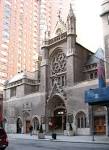
November 14 St. Lawrence O’Toole Patron Saint of Dublin
Lawrence was canonized in the early thirteenth century,t the last person from Ireland (the land of Saints and Scholars) to be so honored until the end of the twentieth century, and has come to symbolize his country’s subjugation to England and isolation from Rome. Lawrence was the son of a chieftain, taken hostage at the age of ten by his lifelong nemesis, King Dermot. Dermot mistreated Lawrence and killed his father, so when Lawrence became bishop of Dublin he banished the old reprobate to England. The Saint brought order to Dublin, inviting thirty homeless people to dinner each night. Years earlier Pope Adrian IV (a Norman Englishman, the former Nicholas Breakspear) had ceded Ireland to King Henry II of England, effectively given the most Catholic and Celtic of countries over to the Norman English. The traitorous King Dermot and his new (English) son-in-law, the earl of Pembroke (the infamous Strongbow), invaded Ireland. The Irish rallied around their high king, Rory O’Connor, but were defeated by Strongbow. Lawrence negotiated the treaty between the English king and the Irish high king, and when that treaty failed Ireland’s “troubles’ began. Henry II arrived on Irish shores, claiming the country give him by one Pope, a claim approved by a subsequent Pope, Alexander III, who went on to demand a Peter’s pence from Ireland for Rome. Lawrence continued to work for peace, traveling constantly to England. On his last mission he was snubbed by Henry II who forbade him to return to Ireland. He sided in France, but his last words were in Irish: translated, they say, “Alas! You stupid, foolish people, what will you do now? Who will look after you in your misfortunes??
Postscript: In 2012, Gypsies (“Travelers”) known for dealing in rhinoceros’ horns, stole Lawrence’s heart from a Dublin Cathedral: http://www.huffingtonpost.com/2012/03/05/ireland-saint-laurence-otoole-heart-stolen-dublin-cathedral_n_1321494.html








